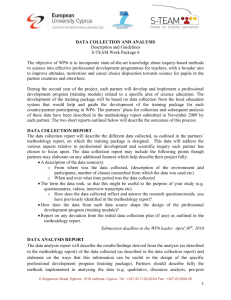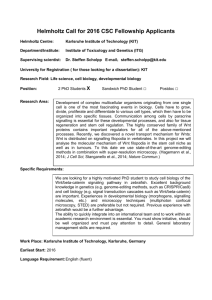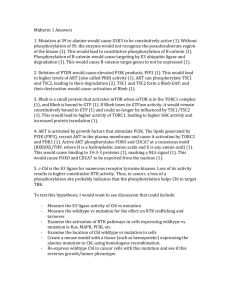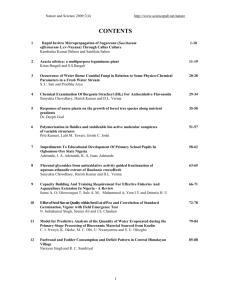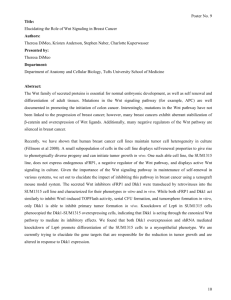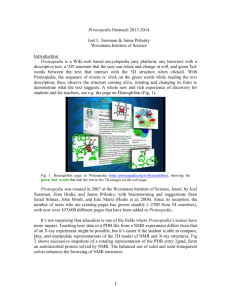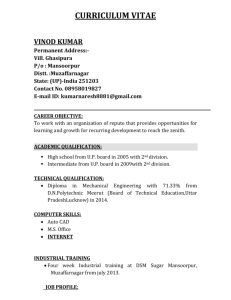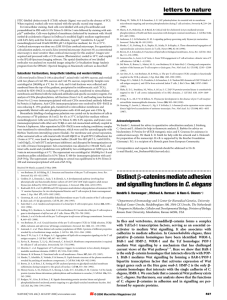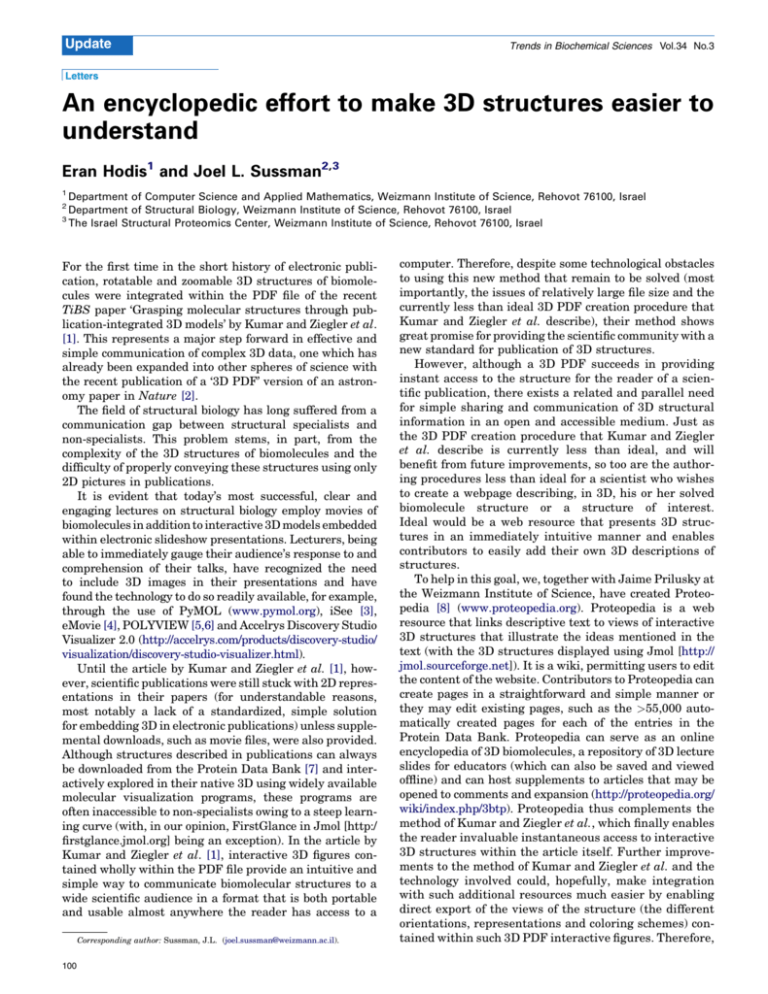
Update
Trends in Biochemical Sciences Vol.34 No.3
Letters
An encyclopedic effort to make 3D structures easier to
understand
Eran Hodis1 and Joel L. Sussman2,3
1
Department of Computer Science and Applied Mathematics, Weizmann Institute of Science, Rehovot 76100, Israel
Department of Structural Biology, Weizmann Institute of Science, Rehovot 76100, Israel
3
The Israel Structural Proteomics Center, Weizmann Institute of Science, Rehovot 76100, Israel
2
For the first time in the short history of electronic publication, rotatable and zoomable 3D structures of biomolecules were integrated within the PDF file of the recent
TiBS paper ‘Grasping molecular structures through publication-integrated 3D models’ by Kumar and Ziegler et al.
[1]. This represents a major step forward in effective and
simple communication of complex 3D data, one which has
already been expanded into other spheres of science with
the recent publication of a ‘3D PDF’ version of an astronomy paper in Nature [2].
The field of structural biology has long suffered from a
communication gap between structural specialists and
non-specialists. This problem stems, in part, from the
complexity of the 3D structures of biomolecules and the
difficulty of properly conveying these structures using only
2D pictures in publications.
It is evident that today’s most successful, clear and
engaging lectures on structural biology employ movies of
biomolecules in addition to interactive 3D models embedded
within electronic slideshow presentations. Lecturers, being
able to immediately gauge their audience’s response to and
comprehension of their talks, have recognized the need
to include 3D images in their presentations and have
found the technology to do so readily available, for example,
through the use of PyMOL (www.pymol.org), iSee [3],
eMovie [4], POLYVIEW [5,6] and Accelrys Discovery Studio
Visualizer 2.0 (http://accelrys.com/products/discovery-studio/
visualization/discovery-studio-visualizer.html).
Until the article by Kumar and Ziegler et al. [1], however, scientific publications were still stuck with 2D representations in their papers (for understandable reasons,
most notably a lack of a standardized, simple solution
for embedding 3D in electronic publications) unless supplemental downloads, such as movie files, were also provided.
Although structures described in publications can always
be downloaded from the Protein Data Bank [7] and interactively explored in their native 3D using widely available
molecular visualization programs, these programs are
often inaccessible to non-specialists owing to a steep learning curve (with, in our opinion, FirstGlance in Jmol [http:/
firstglance.jmol.org] being an exception). In the article by
Kumar and Ziegler et al. [1], interactive 3D figures contained wholly within the PDF file provide an intuitive and
simple way to communicate biomolecular structures to a
wide scientific audience in a format that is both portable
and usable almost anywhere the reader has access to a
Corresponding author: Sussman, J.L. (joel.sussman@weizmann.ac.il).
100
computer. Therefore, despite some technological obstacles
to using this new method that remain to be solved (most
importantly, the issues of relatively large file size and the
currently less than ideal 3D PDF creation procedure that
Kumar and Ziegler et al. describe), their method shows
great promise for providing the scientific community with a
new standard for publication of 3D structures.
However, although a 3D PDF succeeds in providing
instant access to the structure for the reader of a scientific publication, there exists a related and parallel need
for simple sharing and communication of 3D structural
information in an open and accessible medium. Just as
the 3D PDF creation procedure that Kumar and Ziegler
et al. describe is currently less than ideal, and will
benefit from future improvements, so too are the authoring procedures less than ideal for a scientist who wishes
to create a webpage describing, in 3D, his or her solved
biomolecule structure or a structure of interest.
Ideal would be a web resource that presents 3D structures in an immediately intuitive manner and enables
contributors to easily add their own 3D descriptions of
structures.
To help in this goal, we, together with Jaime Prilusky at
the Weizmann Institute of Science, have created Proteopedia [8] (www.proteopedia.org). Proteopedia is a web
resource that links descriptive text to views of interactive
3D structures that illustrate the ideas mentioned in the
text (with the 3D structures displayed using Jmol [http://
jmol.sourceforge.net]). It is a wiki, permitting users to edit
the content of the website. Contributors to Proteopedia can
create pages in a straightforward and simple manner or
they may edit existing pages, such as the >55,000 automatically created pages for each of the entries in the
Protein Data Bank. Proteopedia can serve as an online
encyclopedia of 3D biomolecules, a repository of 3D lecture
slides for educators (which can also be saved and viewed
offline) and can host supplements to articles that may be
opened to comments and expansion (http://proteopedia.org/
wiki/index.php/3btp). Proteopedia thus complements the
method of Kumar and Ziegler et al., which finally enables
the reader invaluable instantaneous access to interactive
3D structures within the article itself. Further improvements to the method of Kumar and Ziegler et al. and the
technology involved could, hopefully, make integration
with such additional resources much easier by enabling
direct export of the views of the structure (the different
orientations, representations and coloring schemes) contained within such 3D PDF interactive figures. Therefore,
Update
we hope to see more articles and journals adopting this
embedded-3D-structure format in the future and a concerted effort to improve the software needed so that it is
accessible to and usable by everyone, non-specialist and
specialist alike.
References
1 Kumar, P. et al. (2008) Grasping molecular structures through
publication-integrated 3D models. Trends Biochem. Sci. 33, 408–
412
2 Goodman, A.A. et al. (2009) A role for self-gravity at multiple length
scales in the process of star formation. Nature 457, 63–66
3 Abagyan, R. et al. (2006) Disseminating structural genomics data to the
public: from a data dump to an animated story. Trends Biochem. Sci. 31,
76–78
Trends in Biochemical Sciences
Vol.34 No.3
4 Hodis, E. et al. (2007) eMovie: a storyboard-based tool for making
molecular movies. Trends Biochem. Sci. 32, 199–204
5 Porollo, A. and Meller, J. (2007) Versatile annotation and publication
quality visualization of protein complexes using POLYVIEW-3D. BMC
Bioinformatics 8, 316
6 Porollo, A.A. et al. (2004) POLYVIEW: a flexible visualization tool for
structural and functional annotations of proteins. Bioinformatics 20,
2460–2462
7 Berman, H.M. et al. (2000) The Protein Data Bank. Nucleic Acids Res.
28, 235–242
8 Hodis, E. et al. (2008) Proteopedia - a scientific ‘wiki’ bridging the rift
between three-dimensional structure and function of biomacromolecules.
Genome Biol. 9, R121
0968-0004/$ – see front matter ß 2009 Elsevier Ltd. All rights reserved.
doi:10.1016/j.tibs.2009.01.001 Available online 18 February 2009
Research Focus
b-catenin gets jaded and von Hippel-Lindau is to blame
Jason D. Berndt, Randall T. Moon and Michael B. Major
Howard Hughes Medical Institute, Department of Pharmacology and Institute for Stem Cell and Regenerative Medicine, University
of Washington School of Medicine, Box 357370, Seattle, WA 98109, USA
Numerous studies have pointed to interactions between
the tumor suppressor von Hippel-Lindau (VHL) and the
oncogenic Wnt–b-catenin signaling cascade; however,
the mechanism of this crosstalk has remained elusive.
Among other roles, VHL can promote the stabilization of
Jade-1. Now, recent findings provide compelling evidence that Jade-1 ubiquitylates b-catenin, leading to
its degradation. Thus, the loss of VHL, as seen in clear
cell renal cell carcinoma, could lead to tumor formation
through b-catenin de-repression.
Wnt–b-catenin signal transduction
Wnts comprise a conserved family of secreted
glycoproteins. The founding member, wingless (wg),
was initially characterized in Drosophila melanogaster
and it was later found to be homologous to a murine
proto-oncoprotein, INT-1 (Wg + INT = Wnt). Wnts are
now known to be crucially important for numerous developmental processes and are required for regeneration in
response to injury. Moreover, constitutive activation of
the Wnt–b-catenin signal transduction pathway
underlies the initiation and progression of several
human cancers, most notably, colorectal carcinoma [1].
Recently, Chitalia et al. [2] described a new mechanism,
via Jade-1 (gene for apoptosis and differentiation in
epithelia), for communication between the Wnt–b-catenin and von Hippel-Lindau (VHL) tumor-suppressor
pathways. Because VHL and Wnt–b-catenin signaling
are implicated in related kidney pathologies, this finding
underscores the clinical relevance of exploring this interaction.
b-catenin, a transcriptional co-activator, is required for
canonical Wnt signal transduction. In the absence of Wnt
Corresponding author: Berndt, J.D. (jdberndt@u.washington.edu).
ligand, b-catenin-dependent transcription is suppressed by
multiple molecular mechanisms, including b-catenin ubiquitylation and proteasome-mediated degradation. A
highly processive enzyme complex comprising casein
kinase 1a, glycogen synthase kinase 3b (GSK3b), the
adenomatosis polyposis coli protein (APC) and Axin phosphorylates conserved serine and threonine residues within
the b-catenin N terminus. Phospho-b-catenin is then ubiquitylated by the Skp 1a-Cullin 1-b-transducin-repeatcontaining protein (SCFbTrCP) E3 ubiquitin ligase complex,
thus targeting it for proteosomal degradation. In the presence of Wnt ligand, b-catenin phosphorylation and ubiquitylation is inhibited and, consequently, b-catenin levels
increase. Similarly, genetic mutations that disrupt the
phosphorylation or ubiquitylation complexes, such as those
frequently observed within the APC gene in colorectal
cancer, also stabilize b-catenin. As b-catenin accumulates,
it translocates to the nucleus, binds members of the lymphoid enhancer-binding factor 1–T-cell specific transcription factor 7 (LEF–TCF) family of transcription factors,
presumably displacing the co-repressors Groucho and Cterminal-binding protein. Transactivation of b-catenin target genes ensues, collectively controlling cellular differentiation, proliferation and migration [3].
Jade-1 negatively regulates b-catenin protein levels
Jade-1 contains two plant homeodomains (PHDs) and a
PEST motif (named for its constituent amino acids, ProGlu-Ser-Thr) and is implicated as a tumor suppressor in
renal cell carcinoma [4]. Chitalia et al. [2] identified bcatenin as one of nine interacting proteins in a yeast twohybrid screen using a form of Jade-1 lacking the PHD
domains as bait. Using endogenous, tagged and recombinant
proteins, the authors convincingly demonstrate that Jade-1
directly binds b-catenin. Interestingly, Jade-1 binds the
b-catenin N terminus, and this association is enhanced by
101



